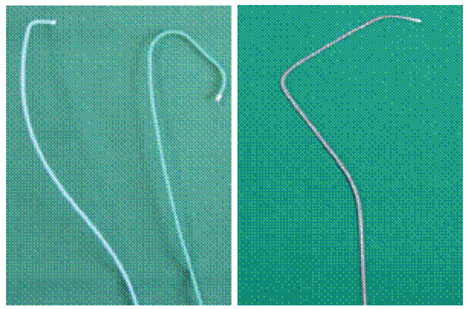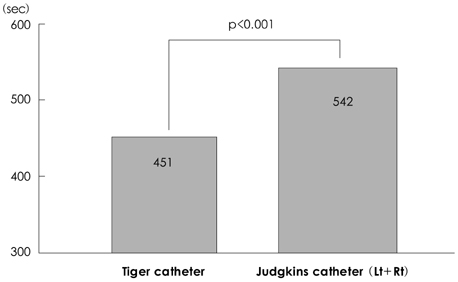Korean Circ J.
2009 Jan;39(1):11-15. 10.4070/kcj.2009.39.1.11.
The Clinical Usefulness of a Tiger Catheter in Diagnostic Coronary Angiography via the Transradial Approach
- Affiliations
-
- 1Cardiovascular Center, Gwangju Veterans Hospital, Gwangju, Korea. mylovekw@hanmail.net
- KMID: 1769507
- DOI: http://doi.org/10.4070/kcj.2009.39.1.11
Abstract
-
BACKGROUND AND OBJECTIVES: The most important complications of the transradial coronary approach during coronary artery angiography are occlusion of the radial artery and arterial spasm which are known to be influenced by catheter size, procedure time, and repeat procedures. The purpose of this study was to evaluate the usefulness of a Tiger catheter (TC) which was designed for the selection of right and left coronary artery ostia simultaneously, compared with the Judgkins catheter (JC) during transradial coronary angiography (CAG).
SUBJECTS AND METHODS
One hundred forty-four patients were randomized between groups who underwent CAG with a standard 5F JC or a TC. The procedure time and vasospasm of the radial artery, which were expressed as stenosis of the vessel diameter, were examined using a transradial approach. Four parts of the blood vessel diameter were measured at baseline, during injection of the vasodilator, and at the end of the procedure.
RESULTS
There were no significant differences in gender, age, weight, or other cardiovascular risk factors between the two groups of patients. CAG was successfully performed using a TC in 89% of the patients. A TC was associated with a significantly shorter total procedure time than the JC for diagnostic CAG (451+/-120.4 vs. 542.3+/-180.5 sec, p=0.001), respectively. There was no significant difference in stenosis between the two groups (36% vs. 41% in TC and JC, respectively, p=0.358). There were no angiographic or clinical complications in each group.
CONCLUSION
This study showed that the TC is associated with decreased total CAG procedure time compared with the JC.
MeSH Terms
Figure
Reference
-
1. Silverman JF, Wexler L. Complications of percutaneous transfemoral coronary arteriography. Clin Radiol. 1976. 27:317–321.2. Campeau L. Percutaneous radial artery approach for coronary angiography. Cathet Cardiovasc Diagn. 1989. 16:3–7.3. Kiemeneij F, Laarman GJ. Percutaneous transradial artery approach for coronary stent implantation. Cathet Cardiovasc Diagn. 1993. 30:173–178.4. Kiemeneij F, Laarman GJ. Transradial artery Palmaz-Schatz coronary stent implantation: result of a single-center feasibility study. Am Heart J. 1995. 130:14–21.5. Slagboom T, Kiemeneij F, Laarman GJ, van der Wieken R. Outpatient coronary angioplasty: feasible and safe. Catheter Cardiovasc Interv. 2005. 64:421–427.6. Valsecchi O, Musumeci G, Vassileva A, et al. Safety and feasibility of transradial coronary angioplasty in elderly patients. Ital Heart J. 2004. 5:926–931.7. Lotan C, Hasin Y, Mosseri M, et al. Transradial approach for coronary angiography and angioplasty. Am J Cardiol. 1995. 76:164–167.8. Ludman PF, Stephens NG, Harcombe A, et al. Radial versus femoral approach for diagnostic coronary angiography in stable angina pectoris. Am J Cardiol. 1997. 79:1239–1241.9. Ikari Y, Ochiai M, Hangaishi M, et al. Novel guide catheter for left coronary intervention via a right upper limb approach. Cathet Cardiovasc Diagn. 1998. 44:244–247.10. Saito S, Miyake S, Hosokawa G, et al. Transradial coronary intervention in Japanese patients. Catheter Cardiovasc Interv. 1999. 46:37–41.11. Goldberg SL, Renslo R, Sinow R, French WJ. Learning curve in the use of the radial artery as vascular access in the performance of percutaneous transluminal coronary angioplasty. Cathet Cardiovasc Diagn. 1998. 44:147–152.12. Ochiai M, Ikari Y, Yamaguchi T, et al. New long-tip guiding catheters designed for right transradial coronary intervention. Catheter Cardiovasc Interv. 2000. 49:218–224.13. Fukuda N, Iwahara S, Harada A, et al. Vasospasms of the radial artery after the transradial approach for coronary angiography and angioplasty. Jpn Heart J. 2004. 45:723–731.14. De Belder AJ, Smith RE, Wainwright RJ, Thomas MR. Transradial artery coronary angiography and intervention in patients with severe peripheral vascular disease. Clin Radiol. 1997. 52:115–118.15. Cowling MG, Buckenham TM, Belli AM. The role of transradial diagnostic angiography. Cardiovas Intervent Radiol. 1997. 20:103–106.16. Cha KS, Kim MH, Kim HJ, et al. Outpatients cardiac catheterization and angiography: safety and experience with transradial approach. Korean Circ J. 1999. 29:1053–1062.17. Archbold RA, Rdbinson NM, Schilling RJ. Radial artery access for coronary angiography and percutaneous coronary intervention. BMJ. 2004. 329:443–446.18. Wu CJ, Lo PH, Chang KC, Fu M, Lau KW, Hung JS. Transradial coronary angiography and angioplasty in Chinese patients. Cathet Cardiovasc Diagn. 1997. 40:159–163.19. Hildick-Smith DJ, Lowe MD, Walsh JT, et al. Coronary angiography from the radial artery: experience, complications and limitations. Int J Cardiol. 1998. 64:231–239.20. Yoo BS, Lee SH, Ko JY, et al. Procedural outcomes of repeated transradial coronary procedure. Catheter Cardiovasc Interv. 2003. 58:301–304.
- Full Text Links
- Actions
-
Cited
- CITED
-
- Close
- Share
- Similar articles
-
- Percutaneous Transradial Approach for Coronary Angiography
- The Reliability and Safety of Selective Carotid Angiography from the Right Transradial Approach
- Feasibility and Problems in Transradial Coronary Angiography and Intervention
- The Safety and Feasibility of Transradial Coronary Angiography Over 70-Year-Old Patients
- A Rare Case of Radial Arteriovenous Fistula After Coronary Angiography



